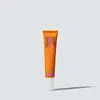What's inside
What's inside
 Key Ingredients
Key Ingredients

 Benefits
Benefits

 Concerns
Concerns

 Ingredients Side-by-side
Ingredients Side-by-side

Water
Skin ConditioningOctocrylene
UV AbsorberSorbitol
HumectantEthylhexyl Salicylate
UV AbsorberButyl Methoxydibenzoylmethane
UV AbsorberPhenylbenzimidazole Sulfonic Acid
UV AbsorberGlyceryl Oleate Citrate
EmulsifyingNiacinamide
SmoothingEthyl Oleate
EmollientCaprylyl Methicone
Skin ConditioningSilica
AbrasivePropanediol
SolventArginine
MaskingHomosalate
Skin ConditioningCetyl Alcohol
EmollientAscorbyl Palmitate
AntioxidantGlyceryl Stearate
EmollientPEG-100 Stearate
Dicaprylyl Carbonate
EmollientLinoleic Acid
CleansingOleic Acid
EmollientHydroxyacetophenone
AntioxidantCaprylic/Capric Triglyceride
MaskingAcrylates/C10-30 Alkyl Acrylate Crosspolymer
Emulsion StabilisingXanthan Gum
EmulsifyingCaffeine
Skin ConditioningBisabolol
Masking1,2-Hexanediol
Skin ConditioningCaprylyl Glycol
EmollientCarnosine
Skin ConditioningHyaluronic Acid
HumectantSodium Gluconate
Skin ConditioningCitric Acid
BufferingTocopherol
AntioxidantPunica Granatum Seed Oil
EmollientGlyceryl Caprylate
EmollientDecyl Glucoside
CleansingLauryl Glucoside
CleansingCetearyl Olivate
Sorbitan Olivate
EmulsifyingGlyceryl Undecylenate
EmollientBentonite
AbsorbentSodium Benzoate
MaskingTocopheryl Acetate
AntioxidantMica
Cosmetic ColorantSodium Metabisulfite
AntioxidantCI 77163
Cosmetic ColorantAlgin
MaskingPotassium Sorbate
PreservativeSodium Lauroyl Lactylate
EmulsifyingResveratrol
AntioxidantCI 77491
Cosmetic ColorantCI 77492
Cosmetic ColorantCI 77499
Cosmetic ColorantCalcium Citrate
BufferingWater, Octocrylene, Sorbitol, Ethylhexyl Salicylate, Butyl Methoxydibenzoylmethane, Phenylbenzimidazole Sulfonic Acid, Glyceryl Oleate Citrate, Niacinamide, Ethyl Oleate, Caprylyl Methicone, Silica, Propanediol, Arginine, Homosalate, Cetyl Alcohol, Ascorbyl Palmitate, Glyceryl Stearate, PEG-100 Stearate, Dicaprylyl Carbonate, Linoleic Acid, Oleic Acid, Hydroxyacetophenone, Caprylic/Capric Triglyceride, Acrylates/C10-30 Alkyl Acrylate Crosspolymer, Xanthan Gum, Caffeine, Bisabolol, 1,2-Hexanediol, Caprylyl Glycol, Carnosine, Hyaluronic Acid, Sodium Gluconate, Citric Acid, Tocopherol, Punica Granatum Seed Oil, Glyceryl Caprylate, Decyl Glucoside, Lauryl Glucoside, Cetearyl Olivate, Sorbitan Olivate, Glyceryl Undecylenate, Bentonite, Sodium Benzoate, Tocopheryl Acetate, Mica, Sodium Metabisulfite, CI 77163, Algin, Potassium Sorbate, Sodium Lauroyl Lactylate, Resveratrol, CI 77491, CI 77492, CI 77499, Calcium Citrate
Ingredients Explained
These ingredients are found in both products.
Ingredients higher up in an ingredient list are typically present in a larger amount.
Caprylyl Glycol is a humectant and emollient, meaning it attracts and preserves moisture.
It is a common ingredient in many products, especially those designed to hydrate skin. The primary benefits are retaining moisture, skin softening, and promoting a healthy skin barrier.
Though Caprylyl Glycol is an alcohol derived from fatty acids, it is not the kind that can dry out skin.
This ingredient is also used as a preservative to extend the life of products. It has slight antimicrobial properties.
Learn more about Caprylyl GlycolCitric Acid is an alpha hydroxy acid (AHA) naturally found in citrus fruits like oranges, lemons, and limes.
Like other AHAs, citric acid can exfoliate skin by breaking down the bonds that hold dead skin cells together. This helps reveal smoother and brighter skin underneath.
However, this exfoliating effect only happens at high concentrations (20%) which can be hard to find in cosmetic products.
Due to this, citric acid is usually included in small amounts as a pH adjuster. This helps keep products slightly more acidic and compatible with skin's natural pH.
In skincare formulas, citric acid can:
While it can provide some skin benefits, research shows lactic acid and glycolic acid are generally more effective and less irritating exfoliants.
Most citric acid used in skincare today is made by fermenting sugars (usually from molasses). This synthetic version is identical to the natural citrus form but easier to stabilize and use in formulations.
Read more about some other popular AHA's here:
Learn more about Citric AcidPropanediol is an all-star ingredient. It softens, hydrates, and smooths the skin.
It’s often used to:
Propanediol is not likely to cause sensitivity and considered safe to use. It is derived from corn or petroleum with a clear color and no scent.
Learn more about PropanediolThis is the synthetic salt of gluconic acid, a form of PHA and mild exfoliant.
It is mainly used to stabilize oil and butter formulations from going bad. Sodium gluconate is a humectant, pH regulator, and chelating agent.
Chelating agents help neutralize unwanted metals from affecting the formulation.
Sodium gluconate is water-soluble.
Learn more about Sodium GluconateWater. It's the most common cosmetic ingredient of all. You'll usually see it at the top of ingredient lists, meaning that it makes up the largest part of the product.
So why is it so popular? Water most often acts as a solvent - this means that it helps dissolve other ingredients into the formulation.
You'll also recognize water as that liquid we all need to stay alive. If you see this, drink a glass of water. Stay hydrated!
Learn more about WaterXanthan gum is used as a stabilizer and thickener within cosmetic products. It helps give products a sticky, thick feeling - preventing them from being too runny.
On the technical side of things, xanthan gum is a polysaccharide - a combination consisting of multiple sugar molecules bonded together.
Xanthan gum is a pretty common and great ingredient. It is a natural, non-toxic, non-irritating ingredient that is also commonly used in food products.
Learn more about Xanthan Gum